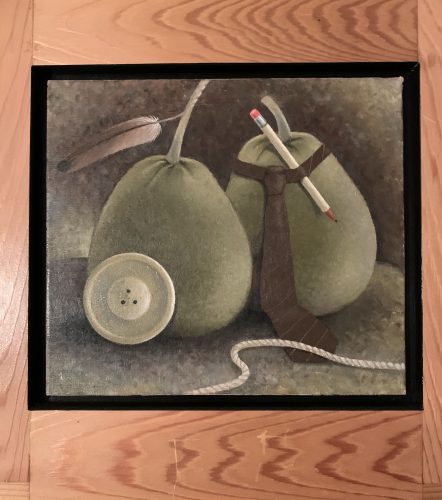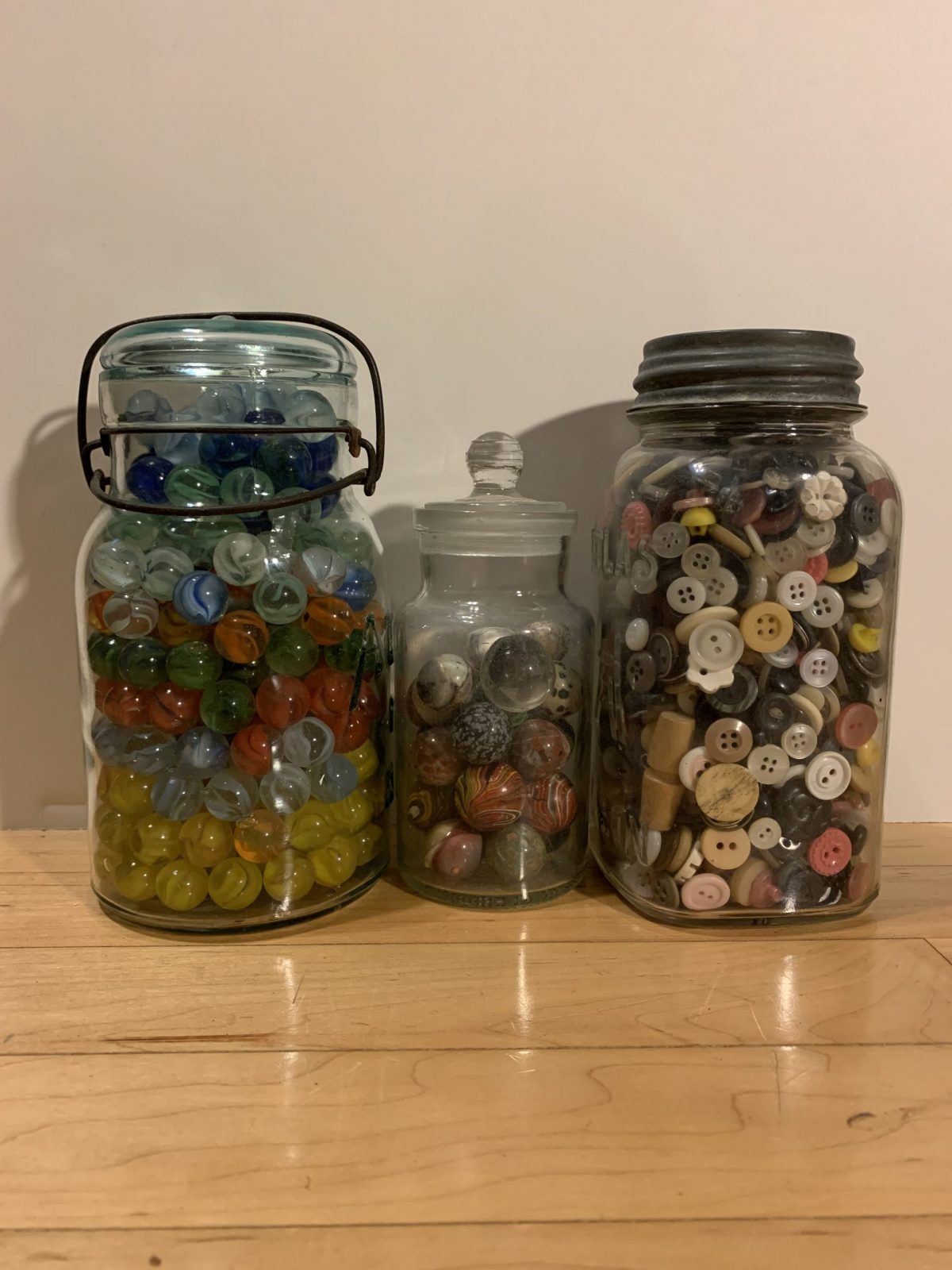Looking for one thing you discover others. My latest discoveries were three bottles, one filled with a collection of assorted buttons, another with small coloured glass marbles and a third smaller one with special prized rock marbles. Because of my passing interest in geology, some years ago I bought the rock marbles as rock specimens at the Museum Shop after a visit to the Geology Section of the Smithsonian Museum.
On one particular visit to the Geology Section of the Guyana National Museum, I was delighted to see Potarite, a new rock specimen named after the Potaro River area in Guyana where it was first found. The owner of an antique shop was curious about my buying the bottles of buttons and small glass marbles as well as a few larger ones. I had to explain that my purchases reminded me of enthusiastic marble games played in the tenement yard of my boyhood days where buttons were used for placing bets. From reading the William Series of books for boys published in the UK, I learnt that the word “aggies” meant agate marbles made in Scotland that were highly prized. Banded agates are the most beautiful and such stones are actually found in the south west corner of the Rupununi in Guyana.

We used different kinds of marbles, depending on what was available and also on the nature of the game. Ceramic marbles imported from the UK were about one inch in diameter .There was a bigger size as well. These were off-white in colour with either blue, yellow or brown spots. Sizeable multicoloured glass marbles were treasured as rare collector’s items not to be used for games. Large steel balls from bearings were obtained mainly from family members or friends who worked at Atkinson Field. The same applied to comic books. Steel balls used as marbles were often banned in games because they could break ceramic or large glass marbles. Hard black awara seeds easily available were most often used and for another good reason. They would bounce further away from the post if you missed the target marble. Ball bearings had no effect on them because they were too resilient as can be tested by attempting to break one with a hammer… safety glasses and a helmet are recommended. Small glass marbles were only used in the game “shooting”…if the name is remembered correctly.
Buttons, which were imported, varied in value. Top of the list were metal postmen and policemen’s buttons with raised designs, mother-of-pearl pajama buttons, large bone buttons, glass buttons, while plastic ones were last. You could pay two or three ordinary glass or plastic buttons for the top buttons. When she was not looking I used to search my Mum’s washing in the wallaba tub for loose buttons and sometimes even “borrowed” mother-of- pearl buttons from Dad’s pajamas. On rainy days we played the guessing game “one-hole two-hole three-hole four-hole”. It was a way of improving your button stock. The holes in a button were covered between thumb and forefinger and the other person had to guess the number. Three-hole buttons existed in my imagination and eventually found a place in my painting Shaddocks. I once visited a market in London and saw a button vendor who travelled across Europe. She had a truly fantastic collection of all kinds made from a wide range of materials. For two Pounds I bought four of the largest large mother-of-pearl buttons I had ever seen, each was 1 3/8 inches in diameter.
“Cush” was a game for two players where instead of marbles large metal washers were used. The stake was usually two buttons and as the game progressed you could increase your button collection for other high stake games. To play “cush” two lines were drawn in the ground and from one line you pitched the washer to rest on the line. The nearest to the line won and the game ended when one player had lost all or most of his buttons.
Before the start of the game called “Jumming,” you had to show your stake. Entry to a game was based on an agreed amount of buttons from each person. The amount could vary in number depending on how “rich” you were.
The button stake in games could vary in number. My friend Colvin Stephenson often tried to bluff his way into games by bundling his short pants pockets in an attempt to show the volume of his stake. He never succeeded. In “jumming”, my “taw” or marble was placed on the ground at the bottom of a concrete or brick pillar. Colvin, standing at a line, had to aim and, stepping forward, launch his marble to try to hit mine. If he scored and his marble was close to mine allowing him to span the two he got three buttons. The span was achieved by using one hand to spread the thumb and middle finger of one hand by using the other both hands to span the distance between marbles This was known as “butt an’ span,” a most desired achievement which also provided an added benefit from exercising fingers. If Colvin missed, it was my turn to hit his marble, providing an opportunity to “butt an’span” and win three buttons. Hit or miss it would be his turn to set his marble in the target spot.
In our game three or more players increased its complexity. A would set his marble, and B, C and D would try to hit it. If none succeeded then A had a chance to hit the marbles of B, C and D, starting with the nearest. With accuracy A could theoretically win a total of nine marbles depending on how near or far apart they were. If A missed D, then D had a chance to “butt an’span,” winning three buttons or win two with just a direct hit. If D missed then it was B’s turn to set his marble.
“Jumming,” to some extent, resembles the French game ‘Boules” played by men. A small target marble would be set and one had to try to roll a larger ball to get it to rest as near as possible to the target. Hitting a competitor’s ball away from the target ball while allowing yours to remain close was a well-used tactic.
Most popular was “holes” or “roll bounce”. Three shallow holes were roughly arranged in a triangle or a crooked line, depending on the available space… The first hole was the nearest to the starting place, which in my case was the flat raised concrete cover of a cistern. Player A would try to get his marble in the first hole by rolling it to ricochet off the surface of the concrete, hence the name “roll bounce”. If successful, he tried the others in succession. If A missed, then B tried and was successful he would try to hit A away from the first hole. If B did so he would then try to enter the second hole. If he missed, C would then enter the game. If he missed the first hole, then A would attempt the first hole. The idea is to prevent others from entering the holes in sequence and in completing the circuit win the betting pool of buttons. It was complex and exciting and one can therefore understand its popularity.
“Roll bounce” was less complicated. A would bounce a marble off a pillar to land on the ground as far away as possible. B would do the same and attempt to hit A’s marble. With a miss A would then try to do the same. The game ends with either a hit, span or “butt an’ span,” which was quite rare. It seems that a similar game using a wall was played in the US.
Both “Jumming “ and “Roll bounce” were banned by householders if ball bearings were used because they pitted the surface of pillars, particularly those made from red bricks sometimes combined with yellow ones. Some 19th Century houses had pillars made from bricks used as ballast in ships. The names of the makers were often seen on such bricks.
“Shooting” was the only game involving glass marbles. A circle was drawn on a level ground and an agreed sum of marbles from each player was scattered in random in the circle. Players took turns to flick a marble with his thumb or roll it to hit others from the circle which are then claimed. Marble games played in my tenement yard were both entertaining, providing opportunities for socializing with friends and acquaintances whose behaviour at times could be quite trying. Sharing a mauby and “buns” at the corner shop was the best form of a treaty ever.






